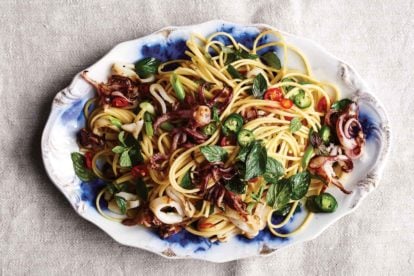Roast That Chicken!
I don’t mean to get preachy, but y’all have to have a simple whole roast chicken in your arsenal. I make one every week – and this recipe for Orange Rosemary Roast Chicken is easy to make and complies with all of Monash University’s low FODMAP science. This recipe is Elimination Phase safe! This means you can rest easy and KNOW that it is a perfect main dish item for us to have in our regular rotation.

We enjoy it the night of and the leftovers lend themselves to creativity – from tacos to enchiladas, soups, stir-fries, sandwiches and more. And it is easy. Super easy.
The Secret to Great Roast Chicken
Want to know the secret to the best roast chicken? Crispy on the outside and juicy on the inside? Leave it alone! And do not open the oven door! That high heat is going to do the work for you. That, and buying a great bird. We like air chilled and buy organic when possible as well.
Place That Orange Where?
Placing a pierced citrus, in this case an orange, in the bird’s cavity might seem odd, but it is one of our favorite techniques and will give you a super juicy result.
Got leftovers? Make our Chicken Salad with Cranberries & Pecans or our Chicken Salad with Gruyere, Tomatoes & Basil.

Low FODMAP Orange Rosemary Roast Chicken
This Low FODMAP Orange Rosemary Roast Chicken will become a weekly recipe for your dinner table. Super easy; crisp skin and juicy flesh.
Ingredients:
- 1, 4-pound (1.8 kg) whole chicken
- 1 tablespoon unsalted butter, softened
- 1 tablespoon Low FODMAP Garlic-Infused Oil, made with olive oil or purchased equivalent such FODY Garlic-Infused Olive Oil
- 2 teaspoons rosemary
- 2 teaspoons kosher salt
- 2 teaspoons freshly cracked black pepper
- 1 orange or tangerine, zested with a rasp-style zester
- Butcher’s twine
Preparation:
-
Remove any giblets or chicken neck from chicken’s cavities. Liver should be discarded; reserve the rest for Chicken Stock. Pat chicken dry inside and out with paper towels. Carefully loosen the skin over the breast by working your fingers between skin and flesh by loosening any connective tissue; set aside and allow to come to room temperature while oven preheats.
-
Position rack in middle of oven. Preheat oven to 450°F/230 ° Have a roasting pan ready that is large enough to hold the chicken with space all around.
-
Combine softened butter, oil, rosemary, salt, pepper and citrus zest in a small bowl. Use this mixture to rub all over the bird’s skin and also under the skin, slathering the breast meat.
-
Prick the orange or tangerine several times with a fork and stuff into cavity of chicken. Place chicken, breast side up, in roasting pan. Place in oven, close door and lower temperature to 425°F/220°
-
Roast chicken for about 50 minutes undisturbed. Do not open oven door. The chicken is done when it registers 165°F/74°C in the thickest part of the thigh (make sure thermometer is not touching bone). You can also jiggle the wings and legs and they should feel loose in their sockets, or prick in one spot with the tip of a knife and juices should run clear. Depending on exact size of chicken and how cold it was when it went in the oven the cooking time might vary by about 10 minutes.
-
Rest the chicken for about 10 or 15 minutes, which will allow the juices to distribute. Chicken is ready to serve. Leftovers will keep for about 4 days refrigerated in an airtight container or wrapped well with plastic wrap.
Nutrition
All nutritional information is based on third-party calculations and should be considered estimates. Actual nutritional content will vary with brands used, measuring methods, portion sizes and more. For a more detailed explanation, please read our article Understanding The Nutrition Panel Within Our Recipes.










Amazing. It’s actually even better than my traditional onion and garlic stuffed chicken…which I thought I would miss. Nope! Delicious.
Miranda! How happy this makes us. We are so thrilled to be part of your delicious FODMAP journey!
Could this be done in an instant pot for quicker cooking time?
Hi Kristen, while many stew-like and braised recipes can translate well to the Instapot, the point of this recipe is juicy flesh and crisp skin and the only way to get that is to use a dry heat as directed. Of course you can make chicken in an Instapot, but it will not come out as this recipe intends. BTW if you are an Instapot fan, definitely check out my friend Mark’s books.
Hi there! Just checking, is the rosemary you use in this recipe fresh or dried?
Thank you!
You could use either but in this case this was dried.